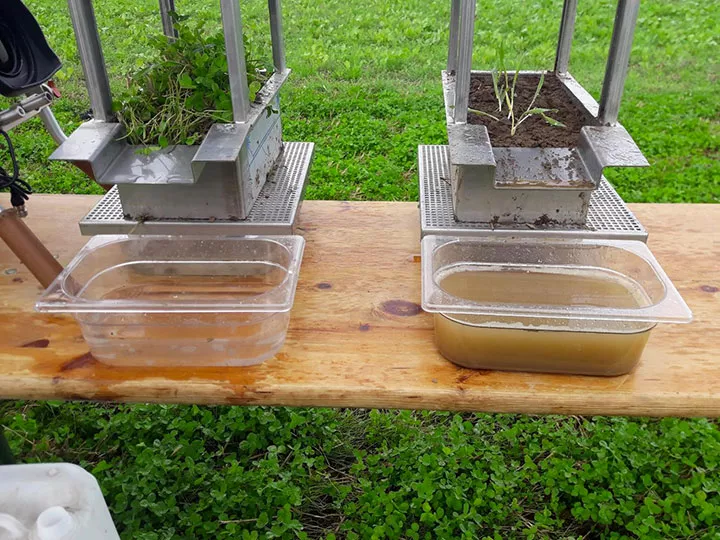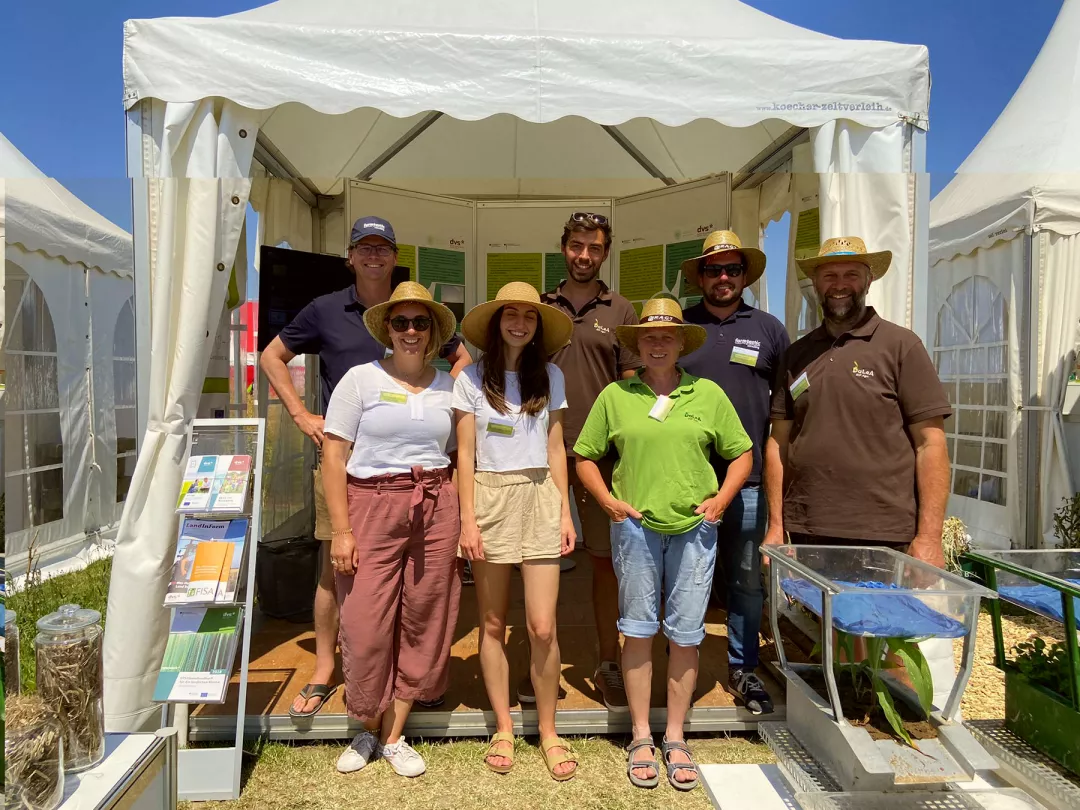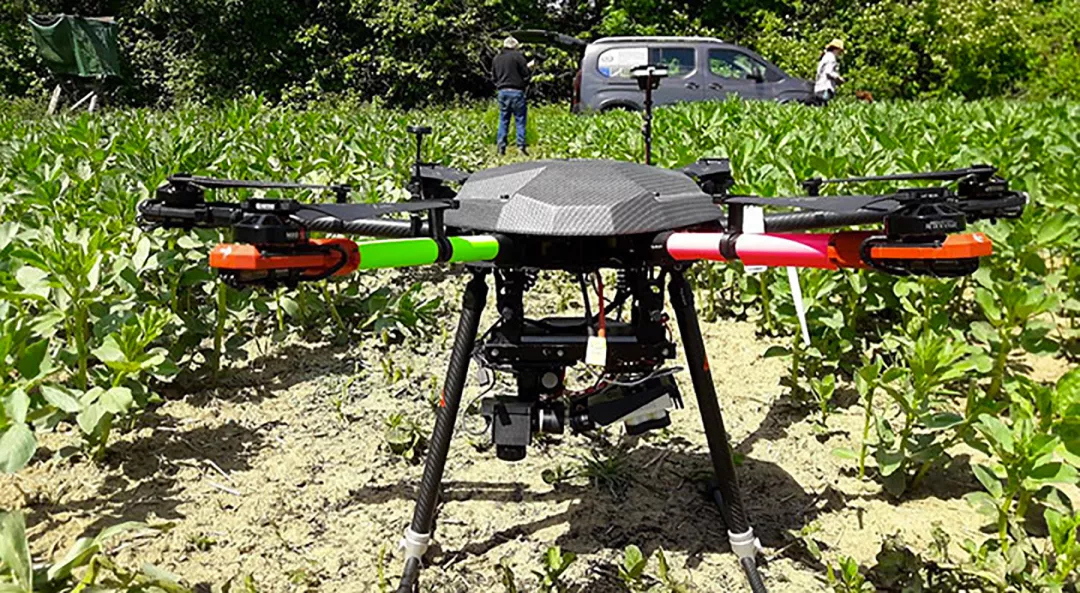General information
RDP Priority
- P4. Ecosystems management
RDP Focus Area
- 4C: Soil erosion & soil management
RDP Measure
- M16: Cooperation
Beneficiary type
- Operational group
Summary
With conventional farming methods not up to the challenge of meeting the goals set by the European Green Deal, innovative agricultural production systems are called for. The DeLeA project (short for Dauerhafter Lebendmulch im Ackerbau, meaning 'permanent living mulch in arable farming') thought that a possible solution would be permanent living mulch: a cover crop permanently interplanted or undersown with a main crop to suppress weed, regulate soil temperature, retain water and minimise tillage.
This is a radical approach, but one that is necessary to combat climate change and the effects it has on crops, soil and yield.
The DaLeA EIP-Agri project’s objective was to test and evaluate the effectiveness of this method, as well as its transferability and feasibility.
Over three years, at three locations and with rotating crops, a cultivation variant using clover as a permanent living mulch was compared to a variant without clover. Despite several setbacks, the approach was a success. Yield difference compared to conventional farming was cut to a third, while nutrient losses and use of fertilisers were minimised.
Results
- Lower greenhouse gas emissions through reduced and more efficient use of production resources.
- Enhanced soil health and biodiversity conservation with implementation of living mulch system.
- Improved water retention and erosion control, contributing to environmental sustainability, also through reduced use of additional nutrients as documented in nitrogen reduction experiment .
- Increased cost-effectiveness for farmers through lower input requirements and improved crop resilience.
- Yield difference to conventional farming significantly lowered from 30-40% (as applicable to ecological farming) in the first year to 10-14% in the third.
- Contribution margin roughly comparable to conventional farming due to the use of fewer utilities e.g. diesel, fertiliser and water .
- Interesting findings on more sustainable use of pesticides may lead to viable solutions after further research in a different context.
- Potential for long-term financial savings by adopting innovative and sustainable agricultural methods.
- Enhanced market competitiveness by aligning with consumer demand for environmentally friendly products.

Promoter
Agrarbüro Mittermeier*
* The Project promoter/beneficiary is an EIP-AGRI Operational Group ©
Funding
Total budget: 304 685 (EUR)
EAFRD: 300 000 (EUR)
Private/Own funds: 4 685 (EUR)
Context

The DaLeA (short for Dauerhafter Lebendmulch im Ackerbau, meaning 'permanent living mulch in arable farming') project was initiated by agricultural practitioners to address the pressing need for sustainable practices in the context of modern farming challenges and to help meet the European Green Deal goals.
The current situation in the agricultural sector is characterised by excessive reliance on chemical inputs, soil erosion and limited biodiversity, which leads to reduced resilience in the face of climate change and market fluctuations.
The farmers and agricultural stakeholders who became part of the DaLeA Operational Group were facing issues related to soil degradation, declining crop yields and environmental concerns due to conventional farming methods. The DaLeA project aimed at introducing permanent living mulch systems as an innovative way to increase soil health and nutrient efficiency, and to promote biodiversity on farms.
A large full-time farm, which had been working with mulch-sowing for 20 years, joined forces with a part-time farm still tilling with a plough to jointly evaluate a permanent living mulch system for farms with such disparate operating modes and develop practical solutions.
Setting up an EIP Operational Group financed by the Rural Development Programme Measure 16 (cooperation) was the obvious choice for the funding application as it is most in step with actual practice and enables projects by practitioners for practitioners.
By integrating research, field trials and knowledge dissemination, the project has empowered farmers with practical tools and insights to transition towards more sustainable farming practices, ultimately contributing to the resilience and viability of agricultural systems in the region.
Objectives
The aims of the project were to establish and evaluate the feasibility of a permanent living mulch system in arable farming while gaining insights into the practical and academic value of crop management, seeding techniques and economics. The project would then assess the performance of main crops under the permanent living mulch system and support further agricultural research through master's theses on sustainable nitrogen management in living permanent mulch systems.
Ultimately, the project findings would be disseminated through various channels to benefit the wider agricultural community.
Activities

The project began at the initiation and planning stage. The project leader formed the project team and established collaboration networks (involving five agricultural practitioners for the practical aspects and scientists and experts in agriculture and environmental science for the research side). Together, these people developed research objectives and methodology for sustainable agriculture practices.
The practical part of the project involved field experiments and data collection. Around 24 field trials were implemented per year to evaluate the effectiveness of sustainable farming techniques such as living mulch systems. Data was collected on crop performance, soil health and environmental impact through a range of exact trials (between 10 and 40 per year, depending on the year’s main research question).
There then followed analysis and evaluation. The team analysed the data collected to assess the impact of innovative agricultural practices on crop productivity and sustainability, and then evaluated the results to identify best practices and areas for improvement.
Once conclusions had been made, it was then important to make this knowledge public and share it with the right audiences. One or two field days per year were held, specifically targeting agricultural stakeholders and attracting up to 300 farmers. Presentations were also made at private advisory circles in Germany and abroad, with one such circle of farm advisors in Sweden continuing to request contributions. The project findings have been disseminated through scientific publications, including research papers and articles in agricultural journals, and the results have been presented at international scientific conferences and events to share insights with the academic community.
It was also important for the project to engage with stakeholders, first and foremost the farmers, and also industry partners and advisory groups, to gather feedback on project outcomes and practical implications. The team members also collaborated with agricultural organisations to promote knowledge exchange and adoption of sustainable practices.
An online presence was also deemed important, so a bilingual (German/English) website was developed and maintained to provide information on project scope, activities and results for agricultural practitioners and a broader audience. Social media channels were also used for regular updates on project progress and upcoming events.
Finally, public events, workshops and field demonstrations were held to showcase project findings, and the group participated in agricultural fairs, conferences and exhibitions to raise awareness of sustainable farming practices.
Main results
Greenhouse gas emissions were lowered through a reduced and more efficient use of production resources, while soil health and biodiversity conservation were enhanced with the implementation of a living mulch system. Water retention and erosion control were also improved, contributing to environmental sustainability through the reduced use of additional nutrients, as documented in a nitrogen reduction experiment.
The change brought about increased cost-effectiveness for farmers through reduced input requirements and improved crop resilience. The yield difference to conventional farming was also significantly lowered, from 30-40% (as applicable to ecological farming) in the first year to 10-14 % in the third.
The contribution margin turned out to be roughly comparable with conventional farming due to the use of fewer utilities, such as diesel, fertiliser and water, while interesting findings on a more sustainable use of pesticides may lead to viable solutions after further research in a different context.
The project made clear the potential for long-term financial savings for farmers by adopting innovative and sustainable agricultural methods, as well as the enhanced market competitiveness to be gained by aligning with consumer demand for environmentally friendly products. It also promoted knowledge exchange and collaboration among farmers, researchers, and policymakers, raised awareness about sustainable agriculture and its positive impact on the environment, and contributed to food security and quality by ensuring stable crop yields and diversified farming practices.
Key lessons
The project emphasised the significance of individual evaluation by farmers based on their experiences and operational backgrounds, highlighting the importance of practical insights in assessing the effectiveness of sustainable farming practices.
Recognising the impact of varying weather conditions and farm-specific approaches, the project underscored the need for adaptability and flexibility in implementing sustainable agricultural systems to address challenges effectively.
The project's evolution from initial objectives to expanded research questions demonstrated the value of continuous learning, exploration and collaboration with scientific partners to generate statistically significant results and practical insights for sustainable agriculture.
Christine Mittermeier

